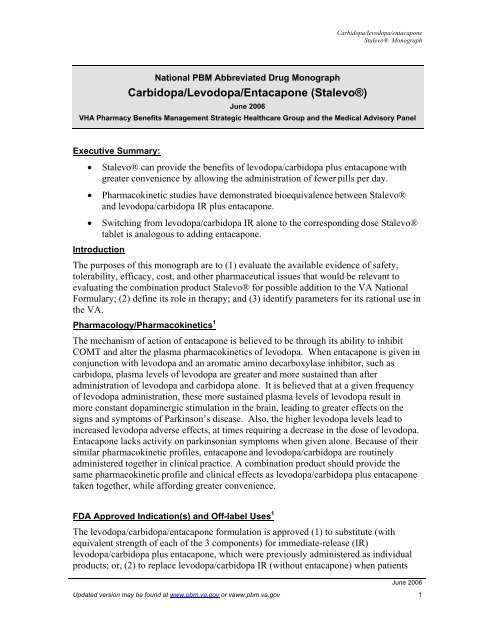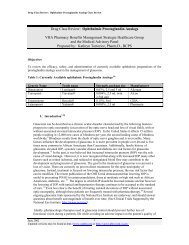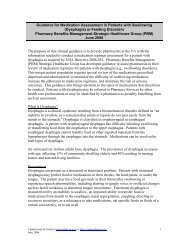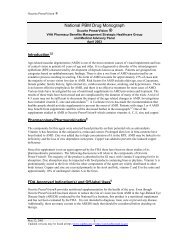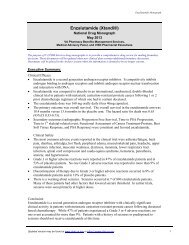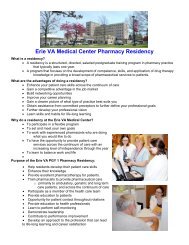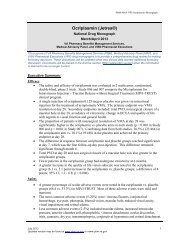Carbidopa/Levodopa/Entacapone (Stalevo®) - Pharmacy Benefits ...
Carbidopa/Levodopa/Entacapone (Stalevo®) - Pharmacy Benefits ...
Carbidopa/Levodopa/Entacapone (Stalevo®) - Pharmacy Benefits ...
You also want an ePaper? Increase the reach of your titles
YUMPU automatically turns print PDFs into web optimized ePapers that Google loves.
<strong>Carbidopa</strong>/levodopa/entacapone<br />
Stalevo® Monograph<br />
National PBM Abbreviated Drug Monograph<br />
<strong>Carbidopa</strong>/<strong>Levodopa</strong>/<strong>Entacapone</strong> (Stalevo®)<br />
June 2006<br />
VHA <strong>Pharmacy</strong> <strong>Benefits</strong> Management Strategic Healthcare Group and the Medical Advisory Panel<br />
Executive Summary:<br />
• Stalevo® can provide the benefits of levodopa/carbidopa plus entacapone with<br />
greater convenience by allowing the administration of fewer pills per day.<br />
• Pharmacokinetic studies have demonstrated bioequivalence between Stalevo®<br />
and levodopa/carbidopa IR plus entacapone.<br />
• Switching from levodopa/carbidopa IR alone to the corresponding dose Stalevo®<br />
tablet is analogous to adding entacapone.<br />
Introduction<br />
The purposes of this monograph are to (1) evaluate the available evidence of safety,<br />
tolerability, efficacy, cost, and other pharmaceutical issues that would be relevant to<br />
evaluating the combination product Stalevo® for possible addition to the VA National<br />
Formulary; (2) define its role in therapy; and (3) identify parameters for its rational use in<br />
the VA.<br />
Pharmacology/Pharmacokinetics 1<br />
The mechanism of action of entacapone is believed to be through its ability to inhibit<br />
COMT and alter the plasma pharmacokinetics of levodopa. When entacapone is given in<br />
conjunction with levodopa and an aromatic amino decarboxylase inhibitor, such as<br />
carbidopa, plasma levels of levodopa are greater and more sustained than after<br />
administration of levodopa and carbidopa alone. It is believed that at a given frequency<br />
of levodopa administration, these more sustained plasma levels of levodopa result in<br />
more constant dopaminergic stimulation in the brain, leading to greater effects on the<br />
signs and symptoms of Parkinson’s disease. Also, the higher levodopa levels lead to<br />
increased levodopa adverse effects, at times requiring a decrease in the dose of levodopa.<br />
<strong>Entacapone</strong> lacks activity on parkinsonian symptoms when given alone. Because of their<br />
similar pharmacokinetic profiles, entacapone and levodopa/carbidopa are routinely<br />
administered together in clinical practice. A combination product should provide the<br />
same pharmacokinetic profile and clinical effects as levodopa/carbidopa plus entacapone<br />
taken together, while affording greater convenience.<br />
FDA Approved Indication(s) and Off-label Uses 1<br />
The levodopa/carbidopa/entacapone formulation is approved (1) to substitute (with<br />
equivalent strength of each of the 3 components) for immediate-release (IR)<br />
levodopa/carbidopa plus entacapone, which were previously administered as individual<br />
products; or, (2) to replace levodopa/carbidopa IR (without entacapone) when patients<br />
June 2006<br />
Updated version may be found at www.pbm.va.gov or vaww.pbm.va.gov 1
<strong>Carbidopa</strong>/levodopa/entacapone<br />
Stalevo® Monograph<br />
experience the signs and symptoms of end-of-dose "wearing off." This second indication<br />
is for patients who are taking a total daily dose of levodopa of 600 mg or less and are not<br />
experiencing dyskinesias. Switching to levodopa/carbidopa/entacapone (with an<br />
equivalent levodopa dose) from levodopa/carbidopa IR alone is analogous to adding<br />
entacapone. Patients with a history of dyskinesia or those who are taking more than 600<br />
mg of levodopa per day are more likely to require a reduction in daily levodopa dose<br />
when entacapone is added.<br />
Current VA National Formulary Alternatives<br />
Currently, the VANF contains carbidopa/levodopa in both immediate and sustained<br />
release preparations and entacapone tablets.<br />
Dosage and Administration 1,2<br />
The recommended dose of entacapone is a 200 mg tablet administered concomitantly<br />
with each levodopa/carbidopa dose to a maximum of 8 times per day. Clinical<br />
experience with doses over 1600 mg is limited.<br />
There is no experience in transferring patients currently treated with formulation of<br />
carbidopa/levodopa other than immediate release carbidopa/levodopa with a 1:4 ratio<br />
(controlled release formulations, or standard release presentations with a 1:10 ratio of<br />
carbidopa/levodopa) and entacapone to the carbidopa, levodopa, and entacapone<br />
combination tablet.<br />
Patients who are currently treated with an entacapone 200 mg tablet with each dose of<br />
standard release levodopa/carbidopa can be directly switched to the corresponding<br />
strength of carbidopa, levodopa, and entacapone combination containing the same<br />
amounts of levodopa and carbidopa. For example, patients receiving 1 tablet of standard<br />
release carbidopa/levodopa 25/100 mg and 1 tablet of entacapone 200 mg at each<br />
administration can be switched to a single Stalevo 100 tablet (containing 25 mg of<br />
carbidopa, 100 mg of levodopa, and 200 mg of entacapone).<br />
In patients with Parkinson disease who experience the signs and symptoms of end-ofdose<br />
“wearing-off” on their current standard release carbidopa/levodopa treatment,<br />
clinical experience shows that patients with a history of moderate or severe dyskinesias<br />
or taking more than 600 mg/day of levodopa are likely to require a reduction in daily<br />
levodopa dose when entacapone is added to their treatment. Since dose adjustment of the<br />
individual components is impossible with fixed dose products, it is recommended that<br />
patients first be titrated individually with a carbidopa/levodopa product (ratio 1:4) and an<br />
entacapone product, and then transferred to a corresponding dose of carbidopa, levodopa,<br />
and entacapone combination once the patient's status has stabilized.<br />
In patients who take a total daily levodopa dose up to 600 mg and who do not have<br />
dyskinesias, an attempt can be made to transfer to the corresponding daily dose of<br />
carbidopa, levodopa, and entacapone combination. However, even in these patients, a<br />
June 2006<br />
Updated version may be found at www.pbm.va.gov or vaww.pbm.va.gov 2
<strong>Carbidopa</strong>/levodopa/entacapone<br />
Stalevo® Monograph<br />
reduction of carbidopa/levodopa or entacapone may be necessary, and the provider is<br />
reminded that this may not be possible with carbidopa, levodopa, and entacapone<br />
combination. Because entacapone prolongs and enhances the effects of levodopa,<br />
individualize therapy and adjust if necessary according to the desired therapeutic<br />
response.<br />
It is also possible to switch patients receiving levodopa/carbidopa controlled-release (CR)<br />
plus entacapone to the levodopa/carbidopa/entacapone formulation. The bioavailability of<br />
levodopa from levodopa/carbidopa CR is approximately 70% to 75% of<br />
levodopa/carbidopa IR. 3 Therefore, the levodopa AUC (concentration area under the<br />
curve) produced by levodopa/carbidopa CR 200 mg/50 mg plus entacapone 200 mg<br />
should be approximately comparable to levodopa/carbidopa/entacapone 150. However,<br />
levodopa from the levodopa/carbidopa/entacapone formulation has a t max similar to that<br />
of levodopa/carbidopa IR (0.5-1.5 hours), whereas absorption is more delayed from<br />
levodopa/carbidopa CR (t max = 1.5-3 hours). 3 These differences in pharmacokinetic<br />
profile need to be considered, but in general, a shorter time to onset of levodopa effect is<br />
desirable in patients with motor fluctuations.<br />
Efficacy 4-6<br />
An open label, multi center trial evaluated the conversion of 169 patients experiencing end of<br />
dose wearing off and/or mild dyskinesias. 4 These patients were receiving levodopa/carbidopa and<br />
were converted to the combination of levodopa/carbidopa/entacapone. Patients were evaluated<br />
with the quality of life instrument PDQ-39, Unified Parkinson’s Disease Rating Scale (UPDRS)<br />
parts II and III and investigator/patient global clinical assessments. Significant improvements in<br />
the PDQ-39 and the UPDRS were seen during combination treatment (35.7 vs 31.8 and 35.4 vs<br />
29.8, respectively, p
<strong>Carbidopa</strong>/levodopa/entacapone<br />
Stalevo® Monograph<br />
Less Frequent:<br />
Anorexia, Anxiety, Back Pain, Bacterial Infection, Blepharospasm, Discoloration of<br />
Sweat, Drowsiness, Dysgeusia, Dyspepsia, Dyspnea, Eyelid Closing, Fainting, Feeling<br />
Agitated, Flatulence, Flushing, Gastritis, General Weakness, Headache Disorder,<br />
Hyperhidrosis, Insomnia, Orthostatic Hypotension, Purpura, Vomiting, Xerostomia<br />
Rare:<br />
Duodenal Ulcer, Fever, Hemolytic Anemia, Hypertension, Impaired Cognition,<br />
Pulmonary Fibrosis, Rhabdomyolysis<br />
Drug Interactions 1<br />
Drug-Drug Interactions<br />
Monoamine oxidase (MAO) and catechol-O-methyltransferase (COMT) are the two<br />
major enzymes systems involved in the metabolism of catecholamines. Therefore,<br />
theoretically, the combination of either entacapone with a non-selective MAO inhibitor<br />
will result in inhibition of the majority of catecholamine metabolism pathways.<br />
Therefore, the concomitant use of either a non-selective MAOI or a selective MAO-A<br />
inhibitor with a selective MAO-B inhibitor with entacapone is contraindicated.<br />
<strong>Entacapone</strong> may be used with selegiline, provided that the daily dose of selegiline does<br />
not exceed 10 mg.<br />
Acquisition Costs<br />
Table 1: FSS pricing of levodopa/carbidopa, entacapone and levodopa/carbidopa/entacapone<br />
Drug Dose Cost/tablet ($)<br />
<strong>Levodopa</strong>/carbidopa<br />
10/100 mg tablet 0.10<br />
(generic)<br />
<strong>Levodopa</strong>/carbidopa<br />
25/100 mg tablet<br />
(generic)<br />
0.11<br />
<strong>Entacapone</strong> 200 mg tablet 1.20<br />
<strong>Levodopa</strong>/carbidopa/entacapone 12.5/50/200 mg 1.31<br />
<strong>Levodopa</strong>/carbidopa/entacapone 25/100/200 mg 1.31<br />
Prices as of 8/05<br />
Therefore the cost of a dose when the individual components are used is $1.30 (0.10<br />
+1.20) versus the combined product $1.31.<br />
Pharmacoeconomic Analysis<br />
A Markov model has been used to demonstrate the cost effectiveness of the combination product<br />
levodopa/carbidopa/entacapone over standard of care in Parkinson’s disease patients. 7 In this<br />
model the costa and outcomes were projected over a 10 year period and were interpreted from a<br />
societal and payer perspective. Treatment with the combination product produced an average gain<br />
of 1.04 quality adjusted life years (QALY) per patient. This therapy also resulted in an increase in<br />
direct costs per patient over the 10 year period. The incremental cost effectiveness ratio (ICER)<br />
June 2006<br />
Updated version may be found at www.pbm.va.gov or vaww.pbm.va.gov 4
<strong>Carbidopa</strong>/levodopa/entacapone<br />
Stalevo® Monograph<br />
was £3105 per QALY gained. The added cost of the medication is likely exceeded by savings<br />
made in other areas (increased clinic appointment, increased physical therapy or homecare<br />
nursing, etc).<br />
Conclusions<br />
The combination of levodopa/carbidopa/entacapone has been proven to be safe and<br />
effective as a management therapy for end of dose wearing off and mild dyskinesias<br />
experience by Parkinson’s disease patients. Additionally, conversion to the combination<br />
product is possible in patients receiving the components separately. A pharmacoecnomic<br />
analysis demonstrated the product to be cost effective over stand care<br />
(levodopa/carbidopa and other agents such as selegiline and dopamine agonists).<br />
References:<br />
1. Product Labeling. Stalevo® levodopa/carbidopa/entacapone. Novartis Pharmaceuticals<br />
Corporation, East Hanover, NJ. 2004<br />
2. Hauser RA. <strong>Levodopa</strong>/carbidopa/entacapone (Stalevo).Neurology. 2004 Jan 13;62(1 Suppl<br />
1):S64-71<br />
3. Yeh KC, August TF, Bush DF, et al. Pharmacokinetics and bioavailability of Sinemet CR: a<br />
summary of human studies. Neurology. 1989; 39 (suppl 2): 25–38.<br />
4. Koller W, Guarnieri M, Hubble J, Rabinowicz AL, Silver D. An open-label evaluation of the<br />
tolerability and safety of Stalevo (carbidopa, levodopa and entacapone) in Parkinson's disease<br />
patients experiencing wearing-off. J Neural Transm. 2005 Feb;112(2):221-30.<br />
5. Brooks DJ, Agid Y, Eggert K, Widner H, Ostergaard K, Holopainen A. Treatment of End-of-Dose<br />
Wearing-Off in Parkinson's Disease: Stalevo <strong>Levodopa</strong>/<strong>Carbidopa</strong>/<strong>Entacapone</strong>) and<br />
<strong>Levodopa</strong>/DDCI Given in Combination withComtess((R))/Comtan((R)) (<strong>Entacapone</strong>) Provide<br />
Equivalent Improvements in Symptom Control Superior to That of Traditional <strong>Levodopa</strong>/DDCI<br />
Treatment. Eur Neurol. 2005 Jun 20;53(4):197-202<br />
6. Onofrj M, Thomas A, Vingerhoets F, Martin W, Gimenez-Roldan S, Azulay JP, Bernhard G,<br />
Schmidt W, Markabi S. Combining entacapone with levodopa/DDCI improves clinical status and<br />
quality of life in Parkinson's Disease (PD) patients experiencing wearing-off, regardless of the<br />
dosing frequency: results of a large multicentre open-label study. J Neural Transm. 2004<br />
Aug;111(8):1053-63.<br />
7. Findley LJ, Lees A, Apajasalo M, Pitkanen A, Turunen H. Cost-effectiveness of<br />
levodopa/carbidopa/entacapone (Stalevo) compared to standard care in UK Parkinson's disease<br />
patients with wearing-off. Curr Med Res Opin. 2005 Jul;21(7):1005-14.<br />
Prepared January 2006. Contact person: Kathryn Tortorice Pharm D, BCPS<br />
June 2006<br />
Updated version may be found at www.pbm.va.gov or vaww.pbm.va.gov 5


